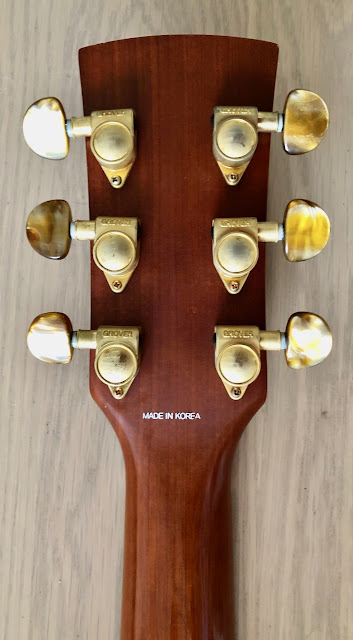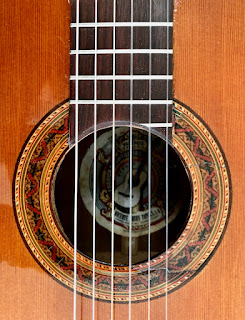received a new bone nut and bridgebone.
where the prefixes S.R.C. behind the company name attests.
nieuwe topkam en brugbeentje. Wat een verschil in geluid!
Close up van de nieuwe topkam en het fretwerk.
een laat 60-er jaren begin zeventiger jaren exemplaar.
Een gitaar die weer in oude luister is teruggebracht.
Wellicht wel erg veel werk voor zo'n gitaar maar ik
laat dan vaak de klank van zo'n instrument de door-
slag geven en die was veelbelovend.
Los van de klank die er eigenlijk al was, zijn er mooie
details te bewonderen aan deze gitaar. Een fraaie rozet.
Als je dan vaak met Spaanse gitaren te maken krijgt,
weet je de specifieke bouwkenmerken ook meteen te
plaatsen. Zo is lijkt de typische punt in de bracing hier
direct te verwijzen naar de manier waarop Manuel
Adalid werkt aan de higher end Esteve gitaren.
Een luxere bedekking van het snarenblok lijkt een beetje
overbodig maar dit hardere materiaal voorkomt wel groeven
in het hout van de kam na langdurig en intensief gebruik.
De hoek van de hals ten opzichte van de klankkast is na verloop
van tijd ook dusdanig dat de speelactie onmogelijk wordt, doordat
de hals wat naar voren is gekomen. Het aanlopen van de snaren
vanaf de 12e fret wijst daar vaak al op. Alle frets eruit, uit-
vlakken naar de kop toe verandert de hoek van de hals ten
opzichte van de kast voldoende om alles weer correct te
krijgen en nieuwe frets zijn na het vele spelen geen
overbodige luxe.
Mooie kwaliteit hout voor de achter- en zijkanten
maar geen palissander wat men wellicht zou verwachten.
Daarentegen wel weer een luxe scheidingsstrip tussen
de twee helften van het achterblad.
De min of meer "geschaduwde " hak van deze gitaar
was in feite een must omdat de hak blijkbaar schade
had opgelopen in het gebruik en een mogelijke val.
Een en ander is opnieuw verlijmd en stevig voor
jaren toekomstig speelplezier.
Ook de rozet moest gestabiliseerd worden maar daar
is na verlijming geen cosmetische operatie meer aan
gewaagd. Hoort ook een beetje bij de geschiedenis
van deze gitaar.
Een wat meer ongebruikelijke kopvorm, overigens wel thuis
te brengen bij de duurdere modellen. Gelukkig kan veel terug-
gehaald worden door de site van Ton Bogaard te raadplegen:
https://guitarrasvalencia.wordpress.com
De hak die nu weer geheel stabiel is.
Het label met de hals naar rechts wijzend geeft een
tijdperk aan. Dan is internet toch een schatkamer voor
dit soort informatie: In elk geval van voor 1973.
De net wat luxere mechanieken en een topkam waarvan
de groeven uiteraard op de juiste diepte zijn gemaakt.
De rozet met zoals vermeld de beschadiging onderin.
Wel mooi van kleur ten opzichte van het bovenblad
Alles ziet er weer correct uit met een prettige
bespeelbaarheid.
De kopfineer is hier al weer aangepakt. Zo te
zien zelfs Brasiliaans palissander.
Toch eens even klikken op de foto om de
fraaie rozet nader te kunnen bestuderen.
De inleg in de zijkanten verraadt ook wel dat
de gitaar zich in een ander echelon bevindt.
Vicente Tatay Tomas Model B-108
Let's start from the beginning but it was within 1 month
that I was able to buy a second Vicente Tatay Tomas B-108.
A lot has to be done on this one as it likely has suffered
some humidity and/or water problems. As can be seen
an extended fingerboard and together with the 5 piece
fan bracing and a scale of 655 mm one can conclude it
to be an intermediate model from this maker.
As opposed to the first Vicente Tatay Tomas this guitar
is executed in all solid woods: Walnut for sides and back
and a fine grained spruce top. Moreover the tuners
were of a better quality. This one wil receive good
but not original tuners and as a lot has to be replaced
already to make it playable again, a lot of original
parts on this guitar will disappear. Often the plastic
rollers are cracked and selling guitars with future
problems is not my goal.
Nice woods with one crack that still close so a good
inspection and a glueing process with cleats will do the job.
This is the pre 1973 "ViTaTo label. Around the label
the walnut pattern can be studied. The other B-108
had a mahogany layer on the back glued inside.
Pictures like this are making it clear that the soundboard is
all solid. Besides that the inner Spanish heel can be studied as
well. Exactly sculpted in the same way as in the other guitar.
The sides are even loose from the endblock as are several
glue blocks for the soundboard / sides so together with a
bit deformed top we might be able to correct that with some
newly made transverse and possibly even fan braces.
I think, compared to the other B-108, the center piece
between the two halves is missing. Also the sides will
be treated with the so called dessication water. Oxal Acid
mixed with water might be able to remove these
ugly traces. A challenge of course.
And the same thing counts for the top that needs to be
refinished. Most likely I will add French polish to it
in order to make a comparison with the other B-108.
On this picture you can clearly see that besides the edge
binding, several glue blocks (side to the top) are missing.
A proper fix inside will only be possible by removing the
back. As the other B-108 was already a positive surprise
sound wise I think it is worth all the efforts.
Shown here is the back off already. Sometimes the braces on
the back will come with the back itself but here the higher
properly glued braces are still sticked to the sides. Otherwise
I would have let them in the soundbox. When heating the outer
back wood that is glued to the inner heel you can simply remove
the back by twisting it from left to right and thus the upper
braces that are left in the soundbox are making this method
of lifting quite simple.
Remarkable that this back already was selected for
a B-108 model as can be seen above the label.
With the back off it is more easy to make a good picture
of the label and moreover to stick it better to the back.
A finely executed 5 fan bracing and one can see
that in the lower right some glue blocks are missing.
I will try to get rid of the ugly discoloration by the
water (or humidity) damage before proceeding
with the glue work. All excessive glue traces will
be removed and every single glue block will be
controlled before the back will be mounted.
Major problem on this example is the water damage this
guitar has developed in the past. Several attempts have been
undertaken but not yet with the ultimate result. The cracks
in this area will also be treated with the back off.
As there are loose parts near the bottom of the soundbox
I figured it would be better to remove the back and be able
to do some necessary glue work including placing new glue
blocks for the soundboard. Another thing is to remove the
transverse just under the sound hole and by remodeling
that one I'm lifting the soundboard a bit. Also therefore that
brace will be strengthened at the outer ends with some
extra studs glued to the sides.
Loose glue blocks are just a part of the problem as the
soundboard edge inlays has to be replaced as well. Some
cracks will be stabilized with extra wooden pieces.
Funnily enough is the prefix "8". most likely
ment to assign this back for a B-108 model guitar.
Another remarkable feature is the solid sides
and back on this furthermore identical model.
As I need to have some patience in working on the next
steps in restoring this guitar, I already removed the copper
frets. In fact not necessary because they didn't had any
wear on them at all but I have to give this guitar a slight
neck reset by shaving of the fingerboard towards the
head. Better fretwork will be installed afterwards.
To stabilize a crack on the right a rosewood piece has been
glued and the same has been done with some smaller cracks
from the fingerboard to the sound hole.
This picture shows the new transverse bar just below the
sound hole. I've added two rosewood braces on the side
to secure that transverse bar while lifting the soundboard
a bit. All the glue blocks will be inspected and reglued
if needed. Before placing the back again some cleaning
is necessary to remove the old glue.












































































